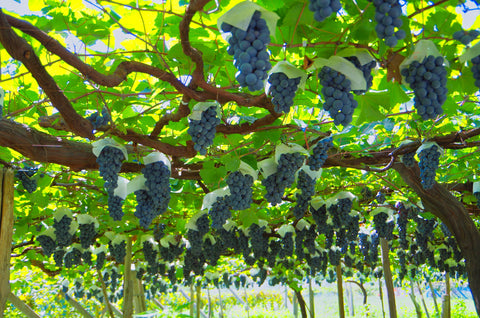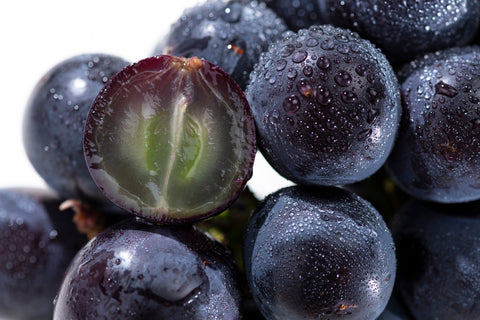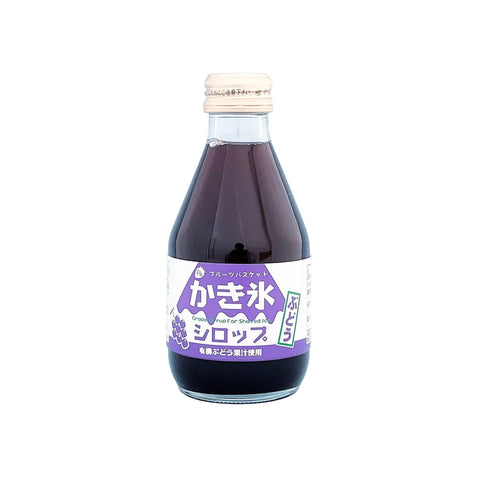
Jump to:
Grapes are a beloved fruit worldwide, with a rich history and countless varieties. Japan in particular is also known for its meticulous approach to fruit cultivation, especially when it comes to high-end fruits. Japan’s particular fruit cultivation has led the country to have its own vast share of unique grapes. In this article, we'll delve into the fascinating world of Japanese grapes, their varieties, flavors, and much more.
Origins of Japanese Grapes
Grapes have two primary places of origin: Western Asia and North America. Numerous grape varieties have emerged from West Asian grapes, and are now widely cultivated across Europe and Asia. In the case of Japan, many of their grape varieties stem from ancient West Asian grapes.
Japanese grapes come in a wide array of colors, shapes, sizes, and flavors, each with its own unique characteristics. Because there are so many varieties of grapes in Japan, and their harvesting seasons slightly differ, you could say that Japanese grape season is paradise for grape lovers.
Where Do Japanese Grapes Grow?

So, where are Japanese grapes primarily grown? Japanese grape cultivation is prevalent in several regions, mainly on the Honshu island (Japan’s main island), from Aomori to Hiroshima, including Hokkaido and Fukuoka. Yamanashi Prefecture, (just west of Tokyo) is the primary production area. Nagano Prefecture, Yamagata Prefecture, and Okayama Prefecture are also significant grape-producing regions.
Cultivating Japanese Grapes

The meticulous process of cultivating Japanese grapes is undoubtedly a labor of love. Farmers carefully prune grape bunches to contain 30 to 35 grapes, ensuring optimum flavor. Grapes are grown in paper bags to shield them from insects. When it's time to harvest, each bunch is hand-selected for uniform color and size. This attention to detail contributes to the premium quality of grapes.
In recent years, certain grape varieties, especially red grapes like the famous Red Ruby Grapes have become especially challenging to cultivate. With climate change and global warming, even minor temperature differences can significantly affect grape coloration. To produce consistently red grapes, advanced technologies are required.
When Japanese Grapes Are Enjoyed
If you want to try Japanese grapes, just remember that the grape season typically falls between August and October. As the autumn months approach, these delectable fruits become readily available, making it the perfect time to savor them!
History Of Japanese Grapes

According to ancient legend, grapes found their way to Japan during the Nara period. They are said to have been introduced from the Tang Dynasty via the Silk Road. In 718, a high priest named Gyoki established a medicinal seed garden at Kashioyama Daizenji Temple in Katsunuma, Kai Province (now Koshu City, Yamanashi Prefecture). Here, he cultivated Koshu grapes, starting a legacy that continues to this day.
The Koshu variety, which has a long history in Japan, is believed to have been introduced to Koshu City, Yamanashi Prefecture, during the Kamakura period. After the East Asian variety of European grapes made its way from China, Koshu grapes gained popularity. During the Meiji period, Japanese grape cultivation saw the introduction of varieties like Delaware and Campbell grapes, which are hybrids of European and American grapes.
After World War I, grape cultivation and winemaking in Japan began to flourish. During World War II, winemaking was encouraged to produce tartaric acid, a crucial material for radio detectors. Following the war, the popularity of Western cuisine led to a dramatic increase in wine production.
How Much Do Japanese Grapes Cost?
The cost of Japanese grapes can vary significantly based on factors like the type and location of purchase. In supermarkets, purple or red Japanese grapes may cost between 800 to 1200 yen (approximately $5-8 USD at the time of writing this article) for a bunch. More premium grapes can cost between 2000 to 5000 yen or even more than 10,000 yen (over $65 USD) in department stores. However, these high-priced grapes are typically intended as gifts and are not for everyday consumption.
Varieties of Japanese Grapes
Japan boasts over 100 grape varieties, with approximately 50 to 60 main ones cultivated. Going over all of them is more than just a little overkill, so we’ll highlight some of the most popular varieties that you should look out for.
Kyoho

The Kyoho (巨峰) grape, translating to "large mountain," is a classic Japanese grape, known for having the perfect amount of sweetness and sourness. This is the most common Japanese grape that you’ll find when you come to Japan. These pink grapes present themselves with an impressive visual impact, boasting an alluring deep hue and round, plump berries.
Delaware

Another popular grape variety is small and features reddish-purple skin, offering a delightful balance of sweetness and sourness. renowned for its petite size and striking reddish-purple skin. Its appeal lies in the unique taste it offers, where a refreshing sweetness meets just a touch of sourness. Delaware grapes present a delightful balance of flavors, making them an excellent choice for those who are looking for grapes with exceptional flavor.
Pione

Pione grapes, which come into season slightly later than Kyoho, are large and incredibly sweet, making them a fan favorite in Japan. With notably larger berries, Pione grapes offer an indulgent sweetness that is reminiscent of a scrumptious dessert. This particular grape variety is celebrated for its high sugar content, translating into an exquisite level of sweetness that permeates every bite. The grapes' inherent low acidity and lack of astringency combine to create an indulgent and elegant grape that enjoys a place of honor in the world of Japanese grapes.
Flavor Profile Of Japanese Grapes
Japanese grapes, which are definitely one of the highlights of the autumn season, are cherished for their wonderful flavors. The Kyoho grape offers a well-balanced profile with refreshing sourness and rich sweetness. Delaware has a refreshing taste with strong sweetness and moderate sourness. Pione is known for its abundant fruit juice, combining strong sweetness with just a touch of sourness.
How To Eat Japanese Grapes

When indulging in Japanese grapes, you'll notice that the skin is thick, tough, and slightly bitter. Many people prefer to peel the skin to savor the juiciness of the berries. If you’ve checked out our article on Japanese peaches, then you’ll know that this is a common trend when it comes to eating Japanese fruits.
Where To Find Japanese Grapes
If you're in Japan during grape season, you can find grapes in local supermarkets or department stores. Keep in mind that grapes sold in department stores are often meant for gifting, with higher price tags. If you're outside Japan, you may find Japanese grapes in local Japanese or Asian supermarkets during grape season, or you can explore online options.
How To Choose The Best Japanese Grapes

When shopping for Japanese grapes, opt for fruits that are not bruised or crushed, have thick stems, and are free from browning. A white powder, known as bloom, on the fruit's surface indicates ripeness and freshness. Grapes with dark skin, whether black or red, are often more delicious. To maintain freshness, avoid washing off the bloom and store the grapes in a newspaper or a plastic bag to prevent drying, ensuring their long-lasting deliciousness.
Japanese Grape Treats
If you can't make it to Japan to savor fresh grapes, you can still enjoy their delightful flavor through Japanese grape-flavored snacks. These treats offer a taste of authentic Japanese grapes, bringing the essence of this beloved fruit to your fingertips.
Orihiro Konjac Jelly Snack Grape Flavor
This grape-flavored konjac jelly from Orihiro is the perfect grape treat option for those looking for a healthier snack option. While the jelly itself is quite low in calories, it is not lacking in grape flavor whatsoever!

[callout-1]
UHA Mikakuto Kororo Grape Gummy Candy
This gummy candy is made with 100% grape juice giving it plenty of juicy grape flavor. Definitely a must-try treat for gummy lovers! We also offer these gummies in a 6 pack option.

[callout-2]
UHA Mikakuto Sakeru 40cm Long Grape Gummy
The Sakeru long grape gummy is a fun snack to try if you love eating Japanese candy snacks. It’s a super long gummy candy that you can eat whole or cut up in pieces and share with your friends and family. The grape flavor in this Japanese gummy candy comes from real Kyoho grape juice making it sweet and refreshingly tart. Yum!

[callout-3]
Fruit Basket Organic Grape Kakigori Shaved Ice Syrup
This one isn’t a snack, but if you’re a kakigori lover and want to try making it at home, why not make a unique Japanese grape flavored one? You can also use this shaved ice syrup to top yogurt or pancakes with!

[callout-4]
Fanta Grape Soda Drink
Last but not least, we can’t forget about the soda lovers out there. This special Japanese Fanta Grape soda has an even fruitier grape flavor that tastes like real grapes.

[callout-5]
Want to learn more about Japanese grapes? Check out our articles on Shine Muscat Grapes and Ruby Roman grapes. If you want to learn more about Japanese fruits, then be sure to check out this article.


0 comments